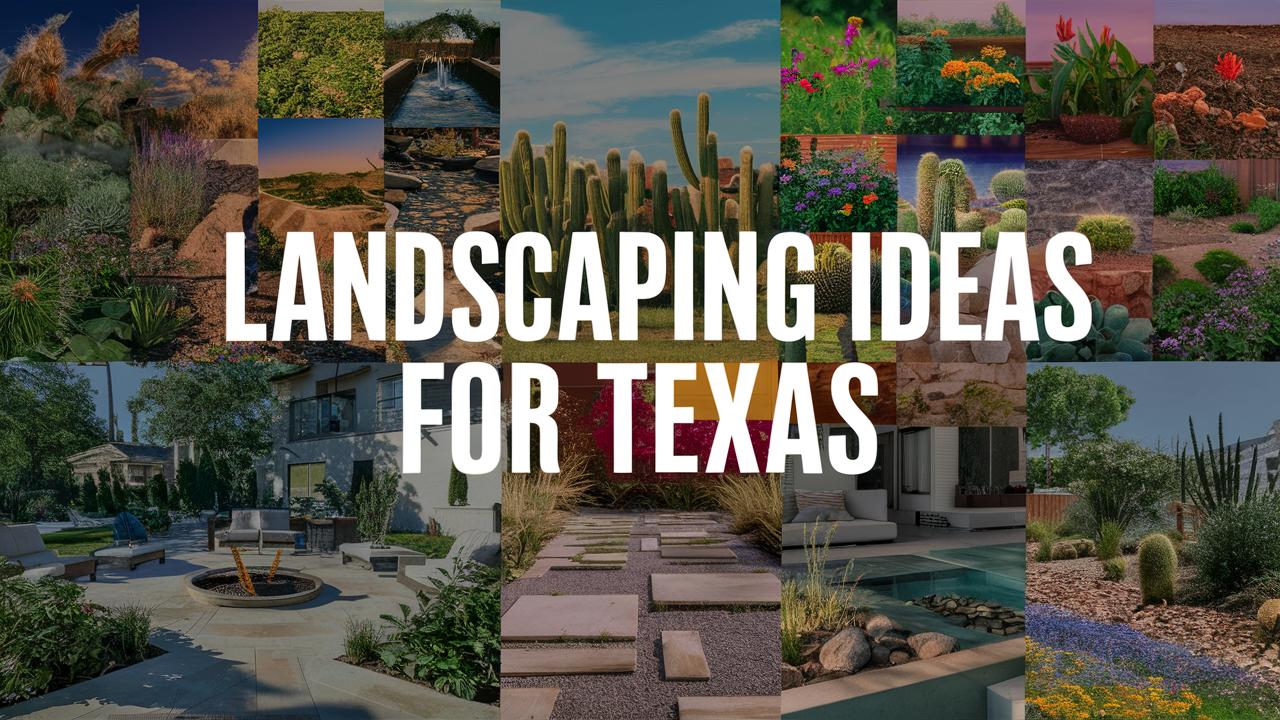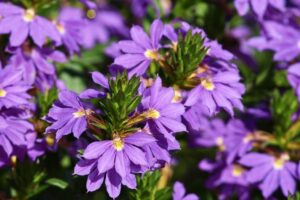This guide seeks to inspire Texas homeowners by showcasing unique landscaping ideas that blend aesthetics with practicality, provide sustainable options, and celebrate the unity of nature and design.
View this post on Instagram
Isn’t this a cool look? I really like how the landscaping follows the lines of the walkway and then adds those layers with the stone. The plants and the lighting really make it feel like a fancy hotel or something. Plus, all that greenery would do really well with our crazy weather here in Texas. Adding some light to your front yard really does make it feel more secure too.
View this post on Instagram
Hey, if you’re into a modern but still totally Texas vibe, check this out. I really dig how they used those clean lines with the concrete planters and gravel, contrasting them with native plants like Yucca and cacti. It makes the green grass pop so much, and those metal borders give it a super polished look. I’m picturing a similar design with maybe some Texas mountain laurel, that would be pretty cool! It’s a great way to keep things drought-tolerant but still have a stylish landscape.
View this post on Instagram
Okay, so here’s something a little different! I love how this design uses those sculpted trees to add some height and structure along the fence line, and the white gravel is so clean and simple, right? But the thing that really makes it pop are those glowing orbs, don’t you think? I imagine they would give it such a cool vibe at night, and they feel a little unexpected, which I appreciate. Maybe you can use them as a base to add your lighting style for the garden!
View this post on Instagram
Want something a little less lawn, and a lot more “wow”? I really dig this design because it’s low-water, perfect for our Texas climate, but still has tons of color and texture. The gravel ground cover keeps things looking clean and modern, while the native plants just thrive. Plus, check out how they used that cool sculpture to add visual interest. I think this would be perfect for someone who’s tired of mowing! The pop of red is a nice accent too.
View this post on Instagram
Hey y’all, check this out for a more modern landscape design! I’m loving the balance of greenery and rock for a low-maintenance, but still super stylish look. The shapes and sizes of the plants really draw your eye across the yard. Imagine swapping out some of those for Texas natives that can handle the heat, and it’d be perfect. The defined borders between the lawn, the gravel and the brick are pretty clean and add to that sleek feel.
View this post on Instagram
Check out this modern landscape design! I really dig the way the xeriscaping complements the architecture. Using native succulents and gravel is super low maintenance, which is a must for Texas summers. Plus, those concrete pavers leading to the front door add a super cool, minimalist touch. I think a similar design would really up my curb appeal without killing my water bill.
View this post on Instagram
This design really captures that Hill Country vibe, doesn’t it? I love how the rugged rocks and gravel mulch complement the spiky yuccas and agaves. That raised planter with the wildflowers adds a pop of color, too. It’s like bringing a little bit of the natural landscape right into your yard, and honestly you can’t go wrong with native grasses in Texas. If you want something low-maintenance but still eye-catching, this could be the one.
View this post on Instagram
Here’s an idea for a landscape that blends modern with a touch of Texas ruggedness, I really love this! The concrete retaining walls and staircase create clean lines, while the natural rock and gravel soften everything and give it that natural Hill Country vibe. It feels both elegant and relaxed, and the drought-tolerant plants look beautiful and are perfect for our Texas climate. The raised planters are a perfect home for beautiful native plants and flowers as well. Think about how you could incorporate those elements into your yard!
View this post on Instagram
Check out this backyard setup! I love how they’ve created a relaxing oasis with the sound of water features trickling down. The mix of the natural stone with the lush green plants and mulch beds is a really nice touch. And can you imagine chilling under that covered pergola with a built-in grill nearby? Totally screams “Texas-style outdoor living” to me. This might be a great inspiration if you are looking to enhance the outdoor entertaining area.
View this post on Instagram
I am loving this clean, modern look with a touch of Texas flair. The brick edging creates a defined space, perfect for those drought-tolerant plants and a few desert-style rocks. Imagine this by your entry way or windows! I think a couple of potted agave are exactly what this space needs. And you can see the fountain grass that add a soft, wispy contrast.
View this post on Instagram
I’m really digging this combo of modern and rustic, and I think you might too! A planter like this with a big agave and some trailing greenery would make a bold statement, and the weathered steel gives it so much character. Adding that chunk of Texas stone nearby really ties it all together. It feels both eye-catching and low-maintenance, which is always a win in my book.
View this post on Instagram
I absolutely love the idea of incorporating a bubbling fountain into my Texas landscape. It’s got this cool, rustic vibe, and the sound of the water is so relaxing! Surrounding it with native grasses and some drought-tolerant perennials like those pink ones would keep it pretty low maintenance too. And a little stone bench nearby? Perfect for just chilling and enjoying the garden. The rocks used for drainage also help keep the water usage low so it’s great for our crazy Texas weather!
View this post on Instagram
I’m really into the idea of a natural stone staircase like this. It would totally transform a sloped area into a cool focal point, don’t you think? Plus, the way the plants are tucked around the stones gives it this effortless, wild Texas vibe that I absolutely love. The low-growing greenery is ideal for our hot climate, and it softens the whole look. It’s a functional and beautiful option all in one!
View this post on Instagram
I think this poolside garden is a beautiful way to add color and texture around your pool! I love how the rock border not only looks natural, but it creates a nice barrier to keep the mulch in place. Imagine relaxing on those lounge chairs next to the vibrant flowers and lush greenery, talk about staycation! Throw in some little landscape lights and you could enjoy this all night. Even better, these are all pretty Texas-friendly plants, so you know they’ll thrive here.
Landscaping Ideas For Texas
Texas, the second-largest state in the United States, boasts a diverse climate and geography that significantly influences landscaping options and choices. With regions ranging from arid deserts to lush forests, the challenge and charm of landscaping in Texas lie in understanding the local environment and selecting plants and designs that enhance the beauty and functionality of the outdoor space.
Understanding Texas’ Climate Zones
Texas covers a vast range of climate zones, from the humid subtropical climate in the east to the arid desert conditions in the west. Before diving into landscaping ideas, it’s crucial to understand these different climates:
East Texas: Characterized by lush vegetation, this region experiences high humidity and ample rainfall, making it suitable for a variety of plants, including deciduous trees, flowering shrubs, and vibrant perennials.
Central Texas: This area faces fluctuating temperatures and is known for its beautiful wildflowers and diverse ecosystems. Drought-tolerant plants thrive here, with many homeowners opting for xeriscaping techniques to conserve water.
North Texas: Here, homeowners deal with cold winters and hot summers, creating a demand for hardy plants that can withstand temperature extremes. Landscaping in this area often includes native grasses and well-adapted trees.
West Texas: Dominated by desert landscapes, West Texas landscaping must focus on drought-resistant and low-water-use plants, highlighting succulents and unique rock formations.
Understanding the specific climate of your region will guide you in choosing the appropriate plants and landscaping designs that not only look great but also thrive in your particular environment.
Embracing Native Plants
One of the best landscaping ideas for Texas is to incorporate native plants into your design. Native plants are adapted to local conditions and require less maintenance once established. By choosing these plants, not only do you create a sustainable landscape, but you also support local wildlife, including pollinators like bees and butterflies. Some popular native plants you might consider include:
Bluebonnet: As the state flower, bluebonnets represent Texas beauty and provide vibrant color in the spring.
Mexican Feather Grass: This soft, wispy grass offers movement and texture, making it a stunning addition to any landscape.
Texas Sage (Cenizo): Not only does this drought-tolerant shrub produce lovely purple flowers, but it also provides a fragrant aroma, attracting pollinators.
Black-eyed Susan: This hardy perennial brings bright yellow blooms that last through the summer, enhancing any garden.
Integrating native plants into your landscape not only conserves water but also fosters a sense of place, connecting your home to Texas’s rich natural heritage.
Xeriscaping: A Sustainable Choice
With the potential for drought conditions in many parts of Texas, xeriscaping has become an increasingly popular landscaping approach. Xeriscaping focuses on water-efficient landscaping practices, promoting drought-resistant plants and minimizing water use. Here are some key elements of xeriscaping to consider:
Soil Preparation: Improving soil quality with organic matter can help retain moisture. Consider testing your soil to understand its pH and nutrient levels, guiding your planting choices.
Drought-Resistant Plants: Opt for plants that thrive in arid conditions, such as red yucca, agave, and various ornamental grasses. These selections not only require less water but also add character to your landscape.
Mulching: Apply a layer of organic mulch around your plants to help retain moisture and suppress weeds. Mulch also contributes to soil health as it breaks down over time.
Irrigation Efficiency: Consider incorporating drip irrigation systems or rainwater harvesting systems. These technologies target water application to the roots of your plants, ensuring maximum efficiency.
By embracing xeriscaping principles, you can create a beautiful and environmentally friendly landscape that withstands the hot Texas sun while conserving water.
Designing Outdoor Living Spaces
Texas homeowners increasingly desire outdoor living spaces that extend the functionality of their homes. Creating comfortable and inviting outdoor areas is essential for entertaining and enjoying the beautiful Texan weather. Here are some ideas to enhance your outdoor space:
Patios and Decks: Construct a natural stone or paver patio to serve as a central gathering area. Consider adding a wooden deck with built-in seating to elevate your outdoor experience.
Firepits and Outdoor Kitchens: An outdoor firepit provides warmth and ambiance during cool Texas evenings, while an outdoor kitchen allows for alfresco dining and entertaining. Include amenities like built-in grills, countertops, and seating for a complete setup.
Shade Structures: Given the intense Texas sun, incorporating shade elements such as pergolas, gazebos, or shade sails will provide comfort while still enjoying outdoor spaces. Vines like wisteria can embellish these structures, offering beauty and shade.
Water Features: Incorporating water features like fountains, small ponds, or even cascading waterfalls can create a peaceful oasis. The sound of flowing water can also drown out noise from nearby streets.
A well-designed outdoor living area allows you to enjoy your landscape fully and takes advantage of the beautiful Texas weather. It creates a perfect haven for relaxation, entertaining, or simply unwinding after a long day.
Incorporating Hardscapes
Hardscaping is the non-plant element within your landscape design and is essential in Texas where harsh weather conditions can affect plant life. Here are several impactful hardscaping options:
Natural Stone Pathways: Building pathways with flagstone or other natural materials can create a beautiful journey through your garden. They also help to minimize soil erosion and provide a solid footing amidst wet conditions.
Rock Gardens: In dry regions, a rock garden can serve as a stunning focal point, showcasing a collection of drought-tolerant plants against a backdrop of stones and boulders.
Retaining Walls: These features can add interest to your landscape while preventing soil erosion. Use local stone to integrate the wall harmoniously into the surrounding landscape.
Edging and Borders: Use brick, wood, or stone edging to define plant beds. This not only keeps mulch and soil contained but also adds structure and cleanliness to your design.
Hardscaping plays a significant role in landscaping, providing functionality, defining spaces, and adding visual appeal. When executed well, it complements the natural elements and enhances your outdoor experience.
Colorful Flower Beds
Creating vibrant flower beds can transform your front or backyard into a colorful paradise. Texas boasts a wealth of beautiful flowering plants that thrive in different regions. Here are some recommendations for your flower beds:
Annuals for Continuous Color: Incorporate annuals like petunias, zinnias, and marigolds that bloom throughout the growing season. Grouping them by color can create striking visuals.
Perennial Plant Choices: For long-lasting beauty, select perennials such as coneflowers, daylilies, and salvias. They offer seasonal interest and attract pollinators.
Seasonal Blooms: Plan a rotating garden that offers diversity throughout the year. Spring bloomers like primrose can yield to summer spectrums of hibiscus and fall displays of asters.
Container Gardening: If space is limited, or if you want to add flexibility to your landscape, consider container gardens. Use vibrant pots to showcase flowers, herbs, or even small shrubs for an accent on patios, porches, or balconies.
A thoughtful flower bed can infuse charm and personality into your Texas landscape, bringing joy to both you and your visitors.
Terracing in Sloped Areas
Texas isn’t completely flat; many homes sit on sloped or uneven terrain. Terracing can be an excellent solution for these challenging areas while adding visual interest and functionality to your landscape:
Creating Levels: Utilize retaining walls to create multi-level flower beds or gardens. These terraced areas can help prevent erosion while providing more space for growing plants.
Edible Landscaping: Terraced gardens are perfect for growing vegetables or fruit trees. This method not only enhances access but also allows for more biodiversity in your landscape.
Steps and Pathways: Incorporate steps or pathways between the terraces, using materials like timber or stone, to facilitate access while enhancing the overall design aesthetic.
Terracing can turn a challenge into an opportunity to cultivate beauty and functionality, transforming a steep slope into an attractive feature of your landscape.
Using Ornamental Grasses
Ornamental grasses are an excellent addition to any Texas landscape. Versatile and easy to maintain, they add movement, texture, and seasonal interest. Here are a few popular ornamental grasses you might consider:
Gulf Coast Muhly: This native grass produces stunning purple flower plumes in the fall, creating a striking backdrop for any garden.
Little Bluestem: A great choice for its hardiness, this grass features blue-green foliage turning red in the fall, providing year-round visual interest.
Mexican Feather Grass: With its wispy and graceful appearance, this grass brings softness to any garden and thrives in dry conditions.
Ornamental grasses are drought-resistant and often require minimal maintenance, making them a smart choice for sustainable landscaping while enhancing the aesthetic appeal of your outdoor space.
Planning for Future Sustainability
In Texas, sustainability in landscaping is becoming increasingly important as concerns about water resources and climate change grow. Here are some best practices that can help you create a sustainable landscape:
Native Plant Landscaping: As mentioned, embracing native plants is key. A landscape filled with native flora reduces the need for chemical fertilizers, pesticides, and excessive watering.
Efficient Irrigation: Implementing timed irrigation systems or using moisture detectors can significantly reduce water waste. Consider using rain barrels to collect rainwater and distribute it as needed.
Soil Health: Focus on building healthy soil through composting and organic practices. Healthy soil supports robust plant life, aids in water retention, and limits the need for chemical inputs.
Carbon Sequestration: Trees and thoughtfully placed plantings can help sequester carbon, making your landscape not only beautiful but also contributing positively to the environment.
By being mindful of sustainable practices, you are not only enhancing your landscape but also playing a part in the preservation and health of Texas’s natural environment.





